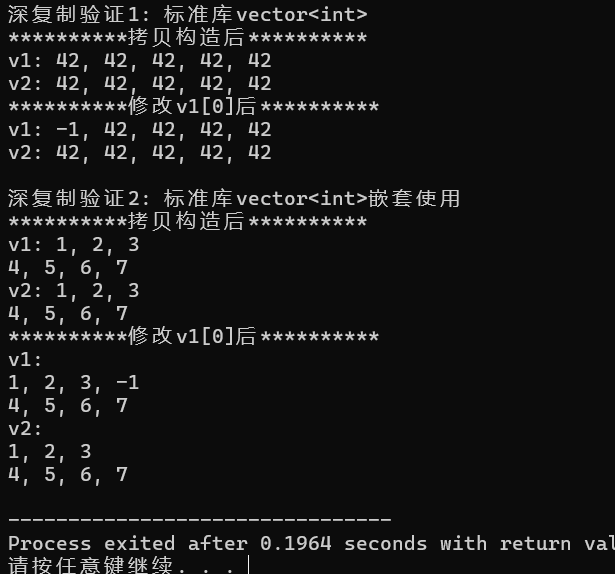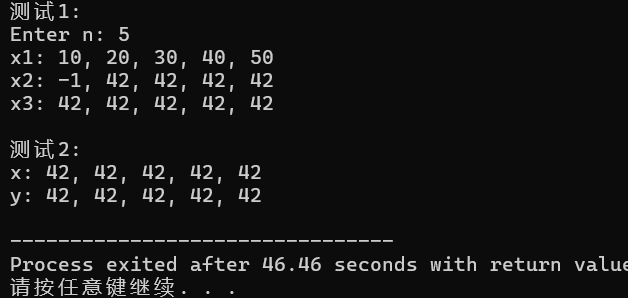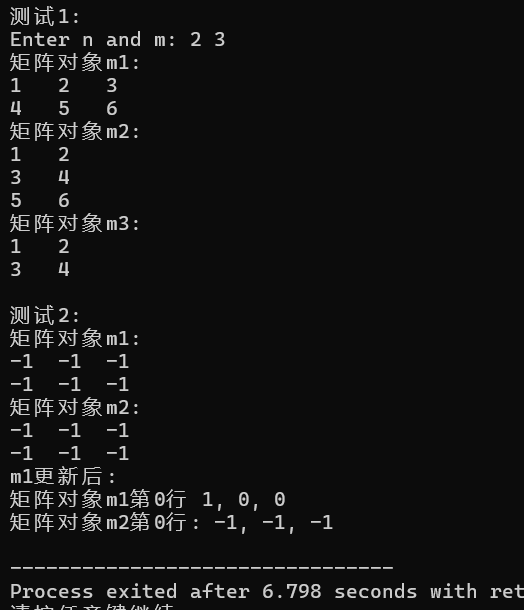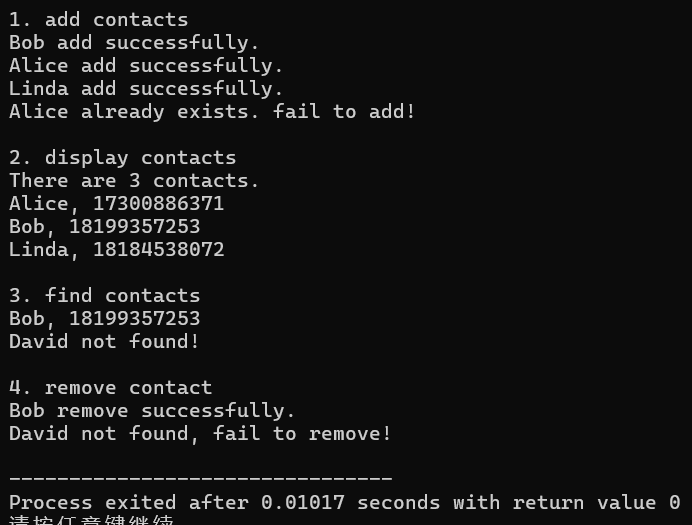实验三
任务1:
源代码:
button.hpp
#pragma once #include <iostream> #include <string> class Button { public: Button(const std::string &label_); const std::string& get_label() const; void click(); private: std::string label; }; Button::Button(const std::string &label_): label{label_} { } inline const std::string& Button::get_label() const { return label; } inline void Button::click() { std::cout << "Button '" << label << "' clicked\n"; }
window.hpp
#pragma once #include <iostream> #include <vector> #include <algorithm> #include "button.hpp" // 窗口类 class Window{ public: Window(const std::string &title_); void display() const; void close(); void add_button(const std::string &label); void click_button(const std::string &label); private: bool has_button(const std::string &label) const; private: std::string title; std::vector<Button> buttons; }; Window::Window(const std::string &title_): title{title_} { buttons.push_back(Button("close")); } inline void Window::display() const { std::string s(40, '*'); std::cout << s << std::endl; std::cout << "window : " << title << std::endl; int cnt = 0; for(const auto &button: buttons) std::cout << ++cnt << ". " << button.get_label() << std::endl; std::cout << s << std::endl; } inline void Window::close() { std::cout << "close window '" << title << "'" << std::endl; click_button("close"); } inline bool Window::has_button(const std::string &label) const { for(const auto &button: buttons) if(button.get_label() == label) return true; return false; } inline void Window::add_button(const std::string &label) { if(has_button(label)) std::cout << "button " << label << " already exists!\n"; else buttons.push_back(Button(label)); } inline void Window::click_button(const std::string &label) { for(auto &button:buttons) if(button.get_label() == label) { button.click(); return; } std::cout << "no button: " << label << std::endl; }
task.cpp
#include "window.hpp" #include <iostream> void test(){ Window w("Demo"); w.add_button("add"); w.add_button("remove"); w.add_button("modify"); w.add_button("add"); w.display(); w.close(); } int main() { std::cout << "用组合类模拟简单GUI:\n"; test(); }
运行结果截图:

问题1:这个范例中, Window 和 Button 是组合关系吗? 是。
问题2: bool has_button(const std::string &label) const; 被设计为私有。 思考并回答:
(1)若将其改为公有接口,有何优点或风险?
优点:能够更加便捷的查看window中是否存在某个按钮;同时使接口更具通用化,不必因为需要判断某个按钮而花费更多的资源与精力。
风险:破坏了window类的封装性,可能会导致内部资源的泄漏。
(2)设计类时,如何判断一个成员函数应为 public 还是 private?
我认为c++类的封闭性十分重要,对于成员函数要暴露必要的部分以供用户进行操作,设置成public,而对于一些对用户没有必要的部分或对用户开放会导致内部资源的混乱的应尽可能设为private。
问题3: Button 的接口 const std::string& get_label() const; 返回 const std::string& 。对比以下两种接口设计在性能和安全性方面的差异并精炼陈述。
接口1: const std::string& get_label() const;
接口2: const std::string get_label() const;
性能方面:接口1返回的为字符串引用类型,不需要分配内存重新存储,资源利用比较好。接口2返回的是字符的复制,需对其分配资源。综合应该是接口1比较好。
安全性方面:接口1返回的是引用类型,如果对应botton被销毁,可能导致其也被销毁。而接口2返回的是字符复制,没有这种隐患。综合应该是接口2安全性较好。
问题4:把代码中所有 xx.push_back(Button(xxx)) 改成 xx.emplace_back(xxx) ,观察程序是否正常运行;查阅资料,回答两种写法的差别。
程序能正常运行。
查阅资料:push_back(Button(xxx)) :先显式创建临时 Button 对象,再将临时对象拷贝到容器中,最后销毁临时对象。emplace_back(xxx) 直接在容器的内存空间中就地构造Button 对象,参数直接传递给Button的构造函数,无需创建临时对象。push_back适合传递已存在的对象;emplace_back 适合直接构造新对象,代码更简洁且性能更高,是 C++11 后推荐的写法。
任务2:
源代码:
源代码:
task2.cpp
#include <iostream> #include <vector> void test1(); void test2(); void output1(const std::vector<int> &v); void output2(const std::vector<int> &v); void output3(const std::vector<std::vector<int>>& v); int main() { std::cout << "深复制验证1: 标准库vector<int>\n"; test1(); std::cout << "\n深复制验证2: 标准库vector<int>嵌套使用\n"; test2(); } void test1() { std::vector<int> v1(5, 42); const std::vector<int> v2(v1); std::cout << "**********拷贝构造后**********\n"; std::cout << "v1: "; output1(v1); std::cout << "v2: "; output1(v2); v1.at(0) = -1; std::cout << "**********修改v1[0]后**********\n"; std::cout << "v1: "; output1(v1); std::cout << "v2: "; output1(v2); } void test2() { std::vector<std::vector<int>> v1{{1, 2, 3}, {4, 5, 6, 7}}; const std::vector<std::vector<int>> v2(v1); std::cout << "**********拷贝构造后**********\n"; std::cout << "v1: "; output3(v1); std::cout << "v2: "; output3(v2); v1.at(0).push_back(-1); std::cout << "**********修改v1[0]后**********\n"; std::cout << "v1: \n"; output3(v1); std::cout << "v2: \n"; output3(v2); } // 使用xx.at()+循环输出vector<int>数据项 void output1(const std::vector<int> &v) { if(v.size() == 0) { std::cout << '\n'; return; } std::cout << v.at(0); for(auto i = 1; i < v.size(); ++i) std::cout << ", " << v.at(i); std::cout << '\n'; } // 使用迭代器+循环输出vector<int>数据项 void output2(const std::vector<int> &v) { if(v.size() == 0) { std::cout << '\n'; return; } auto it = v.begin(); std::cout << *it; for(it = v.begin()+1; it != v.end(); ++it) std::cout << ", " << *it; std::cout << '\n'; } // 使用auto for分行输出vector<vector<int>>数据项 void output3(const std::vector<std::vector<int>>& v) { if(v.size() == 0) { std::cout << '\n'; return; } for(auto &i: v) output2(i); }
运行结果截图:

问题1:测试模块1中这两行代码分别完成了什么构造? v1 、 v2 各包含多少个值为 42 的数据项?
v1、v2都各自包含5个。
问题2:测试模块2中这两行代码执行后, v1.size() 、 v2.size() 、 v1[0].size() 分别是多少?
v1.size() 为2,v2.size()为2, v1[0].size() 为3。
问题3:测试模块1中,把 v1.at(0) = -1; 写成 v1[0] = -1; 能否实现同等效果?两种用法有何区别?
能。区别:在越界的情况下,at()会给出std::out_of_range的异常,而v1[n]则会导致程序崩溃等问题。
问题4:测试模块2中执行 v1.at(0).push_back(-1); 后
(1) 用以下两行代码,能否输出-1?为什么?
能。因为v1.at(0).push_back(-1);向vector的末尾添加了一个-1,而v1.size()-1指向得就是vector的最后的元素。
(2)r定义成用 const & 类型接收返回值,在内存使用上有何优势?有何限制?
优势:节约了复制所用的内存。限制:返回值不可修改同时依赖于v1而存在。
问题5:观察程序运行结果,反向分析、推断:
(1) 标准库模板类 vector 的复制构造函数实现的是深复制还是浅复制?
深复制。
(2) vector<T>::at() 接口思考: 当 v 是 vector<int> 时, v.at(0) 返回值类型是什么?当 v 是 constvector<int> 时, v.at(0) 返回值类型又是什么?据此推断 at() 是否必须提供带 const 修饰的重载版本?
当 v 是 vector<int> 时, v.at(0) 返回值类型是复制引用;当 v 是 constvector<int> 时, v.at(0) 返回值类型是不可变引用;at()必须提供 const 重载版本以保证 const 正确性。
任务3:
源代码:
vectorInt.hpp
#pragma once #include <iostream> // 动态int数组对象类 class vectorInt{ public: vectorInt(); vectorInt(int n_); vectorInt(int n_, int value); vectorInt(const vectorInt &vi); ~vectorInt(); int size() const; int& at(int index); const int& at(int index) const; vectorInt& assign(const vectorInt &vi); int* begin(); int* end(); const int* begin() const; const int* end() const; private: int n; // 当前数据项个数 int *ptr; // 数据区 }; vectorInt::vectorInt():n{0}, ptr{nullptr} { } vectorInt::vectorInt(int n_): n{n_}, ptr{new int[n]} { } vectorInt::vectorInt(int n_, int value): n{n_}, ptr{new int[n_]} { for(auto i = 0; i < n; ++i) ptr[i] = value; } vectorInt::vectorInt(const vectorInt &vi): n{vi.n}, ptr{new int[n]} { for(auto i = 0; i < n; ++i) ptr[i] = vi.ptr[i]; } vectorInt::~vectorInt() { delete [] ptr; } int vectorInt::size() const { return n; } const int& vectorInt::at(int index) const { if(index < 0 || index >= n) { std::cerr << "IndexError: index out of range\n"; std::exit(1); } return ptr[index]; } int& vectorInt::at(int index) { if(index < 0 || index >= n) { std::cerr << "IndexError: index out of range\n"; std::exit(1); } return ptr[index]; } vectorInt& vectorInt::assign(const vectorInt &vi) { if(this == &vi) return *this; int *ptr_tmp; ptr_tmp = new int[vi.n]; for(int i = 0; i < vi.n; ++i) ptr_tmp[i] = vi.ptr[i]; delete[] ptr; n = vi.n; ptr = ptr_tmp; return *this; } int* vectorInt::begin() { return ptr; } int* vectorInt::end() { return ptr+n; } const int* vectorInt::begin() const { return ptr; } const int* vectorInt::end() const { return ptr+n; }
task3.cpp
#include "vectorInt.hpp" #include <iostream> void test1(); void test2(); void output1(const vectorInt &vi); void output2(const vectorInt &vi); int main() { std::cout << "测试1: \n"; test1(); std::cout << "\n测试2: \n"; test2(); } void test1() { int n; std::cout << "Enter n: "; std::cin >> n; vectorInt x1(n); for(auto i = 0; i < n; ++i) x1.at(i) = (i+1)*10; std::cout << "x1: "; output1(x1); vectorInt x2(n, 42); vectorInt x3(x2); x2.at(0) = -1; std::cout << "x2: "; output1(x2); std::cout << "x3: "; output1(x3); } void test2() { const vectorInt x(5, 42); vectorInt y; y.assign(x); std::cout << "x: "; output2(x); std::cout << "y: "; output2(y); } // 使用xx.at()+循环输出vectorInt对象数据项 void output1(const vectorInt &vi) { if(vi.size() == 0) { std::cout << '\n'; return; } std::cout << vi.at(0); for(auto i = 1; i < vi.size(); ++i) std::cout << ", " << vi.at(i); std::cout << '\n'; } // 使用迭代器+循环输出vectorInt对象数据项 void output2(const vectorInt &vi) { if(vi.size() == 0) { std::cout << '\n'; return; } auto it = vi.begin(); std::cout << *it; for(it = vi.begin()+1; it != vi.end(); ++it) std::cout << ", " << *it; std::cout << '\n'; }
运行结果截图:

问题1:当前验证性代码中, vectorInt 接口 assign 实现是安全版本。如果把 assign 实现改成版本2,逐条指 出版本 2存在的安全隐患和缺陷。
delete[] ptr,可能会导致访问子资源失败,并且如果在后面的new int[]分配内存失败,那ptr将无法获取新内存,导致内存资源管理混乱。
问题2:当前验证性代码中,重载接口 at 内部代码完全相同。若把非 const 版本改成如下实现,可消除重复并遵循“最小化接口”原则(未来如需更新接口,只更新const接口,另一个会同步)。
查阅资料,回答:
(1) static_cast<const vectorInt*>(this) 的作用是什么?转换前后 this 的类型分别是什么?转换目的?
将当前对象的 this 指针转换为指向 const vectorInt 对象的指针;转换前:vectorInt*,转换后:const vectorInt*;转换目的:强制让非const对象调用const版本的 at() 接口;
(2) const_cast<int&> 的作用是什么?转换前后的返回类型分别是什么?转换目的?
作用:移除const版本 at()返回值的 const限定。转换前:const int&;转换后:int*。转换目的:非 const的at()允许修改元素,需通过转换解除返回值的 const 限制。
问题3: vectorInt 类封装了 begin() 和 end() 的const/非const接口。
(1)以下代码片段,分析编译器如何选择重载版本,并总结这两种重载分别适配什么使用场景。
auto it1 = v1.begin();会调用非const版本的 begin() ;auto it2 = v2.begin();调用 **const版本的 begin()**。
问题4:以下两个构造函数及 assign 接口实现,都包含内存块的赋值和复制操作。使用算法库 <algorithm> 改成如下写法是否可以?回答这3行更新代码的功能。
可行。
1:从指针ptr指向的内存地址开始,每个内存块存储值为value的元素,一共n个;
2:从vi.ptr指向的内存地址开始,一一复制vi.n个元素到ptr指向的内存中。
3:将vi的n个元素从vi.ptr复制到ptr_tmp指向的内存中。
任务4:
源代码:
matrix.hpp
#pragma once #include <iostream> #include <algorithm> #include <cstdlib> // 类Matrix声明 class Matrix { public: Matrix(int rows_, int cols_, double value = 0); // 构造rows_*cols_矩阵对象, 初值value Matrix(int rows_, double value = 0); // 构造rows_*rows_方阵对象, 初值value Matrix(const Matrix &x); // 深复制 ~Matrix(); void set(const double *pvalue, int size); // 按行复制pvalue指向的数据,要求size=rows*cols,否则报错退出 void clear(); // 矩阵对象数据项置0 const double& at(int i, int j) const; // 返回矩阵对象索引(i,j)对应的数据项const引用(越界则报错后退出) double& at(int i, int j); // 返回矩阵对象索引(i,j)对应的数据项引用(越界则报错后退出) int rows() const; // 返回矩阵对象行数 int cols() const; // 返回矩阵对象列数 void print() const; // 按行打印数据 private: int n_rows; // 矩阵对象内元素行数 int n_cols; // 矩阵对象内元素列数 double *ptr; // 数据区 };
matrix.cpp
#include "matrix.hpp" #include <iostream> #include <iomanip> #include <stdexcept> Matrix::Matrix(int rows_, int cols_, double value ):n_rows(rows_), n_cols(cols_), ptr (new double[rows_*cols_]){ for(int i = 0; i < rows_*cols_; i++) ptr[i] = value; } Matrix::Matrix(int rows_, double value ):n_rows(rows_), n_cols(rows_), ptr (new double[rows_*rows_]){ for(int i = 0; i < rows_*rows_; i++) ptr[i] = value; } Matrix::Matrix(const Matrix &x):n_rows(x.rows() ), n_cols(x.cols() ), ptr(new double[n_rows*n_cols]){ for(int i = 1; i <= n_rows*n_cols; i++) ptr[i-1] = x.at((i-1)/n_cols, (i-1) % n_cols) ; } Matrix::~Matrix() { delete [] ptr; } void Matrix::set(const double *pvalue, int size){ if(pvalue == nullptr || size != n_rows*n_cols){ std::cout << "输入数据错误!" << std::endl; return ; } else{ for(int i = 0; i < size; ++i) ptr[i] = pvalue[i]; } } void Matrix::clear() { for(int i = 0; i < n_rows*n_cols; ++i){ ptr[i] = 0; } } const double& Matrix::at(int i, int j) const{ if(i >= n_rows || j >= n_cols || i < 0 || j < 0){ std::cout << "输入数据错误!" << std::endl; } return ptr[i*n_cols + j]; } double& Matrix::at(int i, int j){ if(i >= n_rows || j >= n_cols || i < 0 || j < 0){ std::cout << "输入数据错误!" << std::endl; } return ptr[i*n_cols + j]; } int Matrix::rows() const{ return n_rows; } int Matrix::cols() const{ return n_cols; } void Matrix::print() const{ for(int i = 0; i < n_rows; ++i){ for(int j = 0; j < n_cols; ++j) std::cout << std::left << std::setw(3) << ptr[i*n_cols + j] << " " ; std::cout << "\n"; } }
task4.cpp
#include <iostream> #include <cstdlib> #include "matrix.hpp" void test1(); void test2(); void output(const Matrix &m, int row_index); int main() { std::cout << "测试1: \n"; test1(); std::cout << "\n测试2: \n"; test2(); } void test1() { double x[1000] = {1, 2, 3, 4, 5, 6, 7, 8, 9, 10}; int n, m; std::cout << "Enter n and m: "; std::cin >> n >> m; Matrix m1(n, m); // 创建矩阵对象m1, 大小n×m m1.set(x, n*m); // 用一维数组x的值按行为矩阵m1赋值 Matrix m2(m, n); // 创建矩阵对象m2, 大小m×n m2.set(x, m*n); // 用一维数组x的值按行为矩阵m1赋值 Matrix m3(n); // 创建一个n×n方阵对象 m3.set(x, n*n); // 用一维数组x的值按行为矩阵m3赋值 std::cout << "矩阵对象m1: \n"; m1.print(); std::cout << "矩阵对象m2: \n"; m2.print(); std::cout << "矩阵对象m3: \n"; m3.print(); } void test2() { Matrix m1(2, 3, -1); const Matrix m2(m1); std::cout << "矩阵对象m1: \n"; m1.print(); std::cout << "矩阵对象m2: \n"; m2.print(); m1.clear(); m1.at(0, 0) = 1; std::cout << "m1更新后: \n"; std::cout << "矩阵对象m1第0行 "; output(m1, 0); std::cout << "矩阵对象m2第0行: "; output(m2, 0); } // 输出矩阵对象row_index行所有元素 void output(const Matrix &m, int row_index) { if(row_index < 0 || row_index >= m.rows()) { std::cerr << "IndexError: row index out of range\n"; exit(1); } std::cout << m.at(row_index, 0); for(int j = 1; j < m.cols(); ++j) std::cout << ", " << m.at(row_index, j); std::cout << '\n'; }
运行结果截图:

任务5:
源代码:
contact.hpp
#pragma once #include <iostream> #include <string> // 联系人类 class Contact { public: Contact(const std::string &name_, const std::string &phone_); const std::string &get_name() const; const std::string &get_phone() const; void display() const; private: std::string name; // 必填项 std::string phone; // 必填项 }; Contact::Contact(const std::string &name_, const std::string &phone_):name{name_}, phone{phone_} { } const std::string& Contact::get_name() const { return name; } const std::string& Contact::get_phone() const { return phone; } void Contact::display() const { std::cout << name << ", " << phone; }
contactBook.hpp
# pragma once #include <iostream> #include <string> #include <vector> #include <algorithm> #include "contact.hpp" // 通讯录类 class ContactBook { public: void add(const std::string &name, const std::string &phone); // 添加联系人 void remove(const std::string &name); // 移除联系人 void find(const std::string &name) const; // 查找联系人 void display() const; // 显示所有联系人 size_t size() const; private: int index(const std::string &name) const; // 返回联系人在contacts内索引,如不存在,返回-1 void sort(); // 按姓名字典序升序排序通讯录 private: std::vector<Contact> contacts; }; void ContactBook::add(const std::string &name, const std::string &phone) { if(index(name) == -1) { contacts.push_back(Contact(name, phone)); std::cout << name << " add successfully.\n"; sort(); return; } std::cout << name << " already exists. fail to add!\n"; } void ContactBook::remove(const std::string &name) { int i = index(name); if(i == -1) { std::cout << name << " not found, fail to remove!\n"; return; } contacts.erase(contacts.begin()+i); std::cout << name << " remove successfully.\n"; } void ContactBook::find(const std::string &name) const { int i = index(name); if(i == -1) { std::cout << name << " not found!\n"; return; } contacts[i].display(); std::cout << '\n'; } void ContactBook::display() const { for(auto &c: contacts) { c.display(); std::cout << '\n'; } } size_t ContactBook::size() const { return contacts.size(); } int ContactBook::index(const std::string &name) const{ if(contacts.size() == 0){ return -1; } int count = 0; auto it = contacts.begin() ; if(it->get_name() == name){ return count; } count++; for(it = contacts.begin()+1; it != contacts.end(); ++it){ if(it->get_name() == name) return count; count++; } return -1; } void ContactBook::ContactBook::sort(){ if(contacts.size() == 0 || contacts.size() == 1) return ; for(auto it1 = contacts.end() - 1 ; it1 != contacts.begin() ; --it1) for(auto it2 = contacts.begin() ; it2 < it1 ; ++it2){ if(it2->get_name() > (it2+1)->get_name()) std::swap(*it2, *(it2+1)); } }
task5.cpp
#include "contactBook.hpp" void test() { ContactBook contactbook; std::cout << "1. add contacts\n"; contactbook.add("Bob", "18199357253"); contactbook.add("Alice", "17300886371"); contactbook.add("Linda", "18184538072"); contactbook.add("Alice", "17300886371"); std::cout << "\n2. display contacts\n"; std::cout << "There are " << contactbook.size() << " contacts.\n"; contactbook.display(); std::cout << "\n3. find contacts\n"; contactbook.find("Bob"); contactbook.find("David"); std::cout << "\n4. remove contact\n"; contactbook.remove("Bob"); contactbook.remove("David"); } int main() { test(); }
运行结果截图:






 浙公网安备 33010602011771号
浙公网安备 33010602011771号